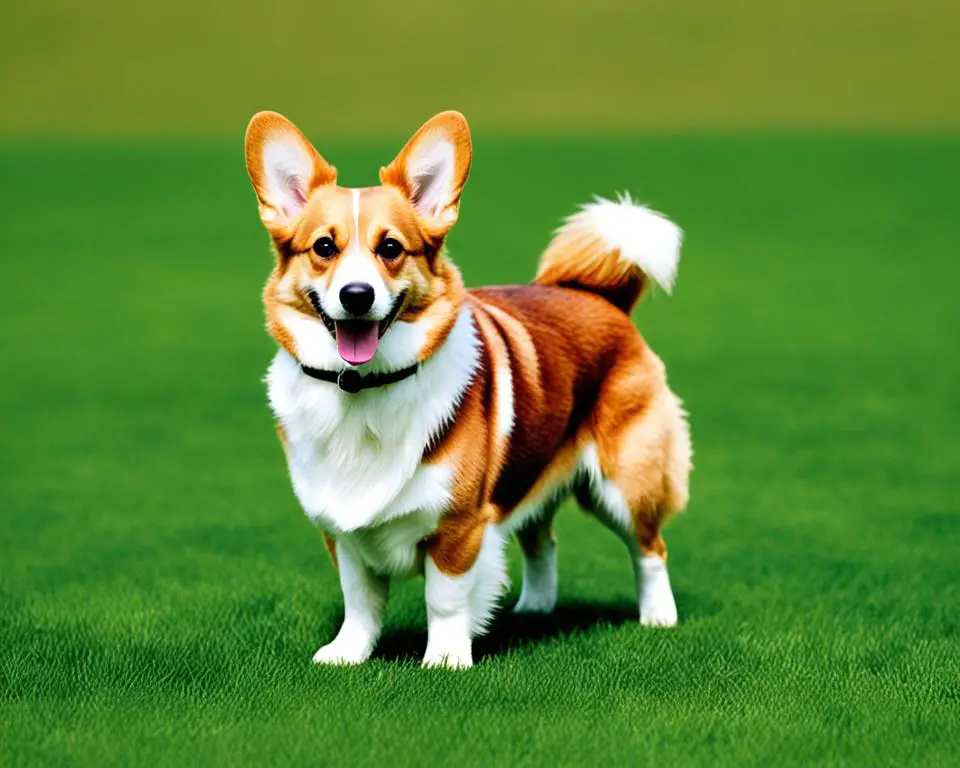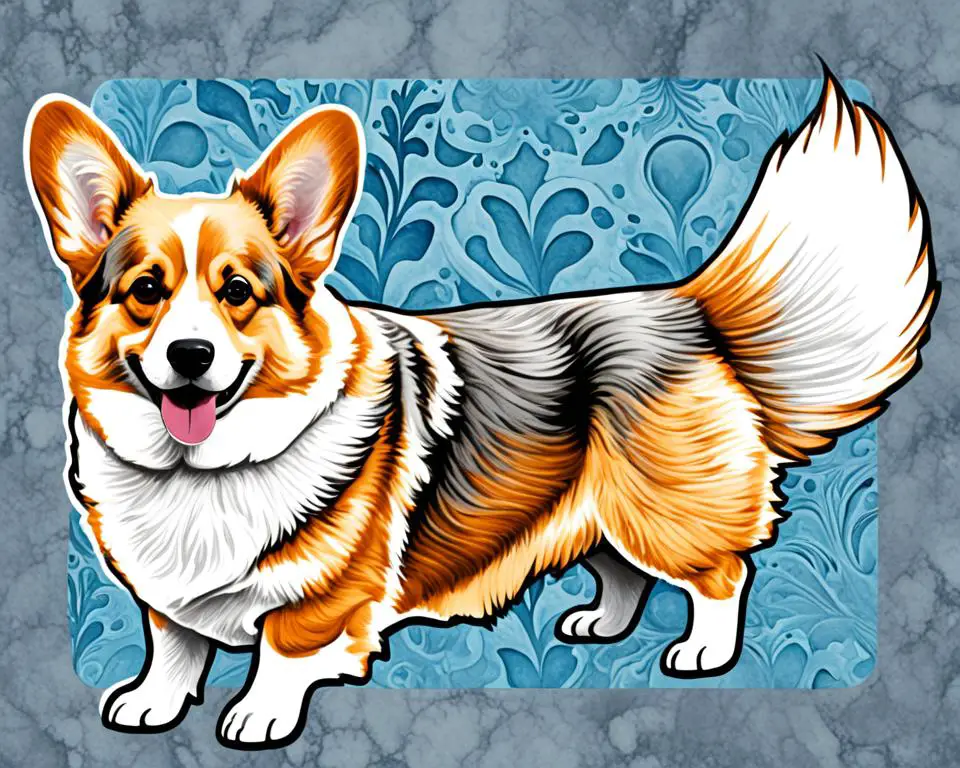When you dive into the world of Corgis, you meet a breed that’s full of life and love. They’re friendly and their short stature makes them stand out. In fact, Corgis are among the top fifteen favorite dogs according to the American Kennel Club. They come from England in the 1930s and quickly became beloved family pets. Knowing about the Corgi weight chart is key for caring for your pet’s health and growth.
This chart tracks the change from a Corgi puppy’s weight to when they’re fully grown. It’s a great way for Corgi owners to keep an eye on their pet’s health. Generally, male and female Corgis grow to about the same size. However, males usually weigh a bit more. The Corgi growth chart helps owners know what to expect as their dog grows. But remember, every dog is different. If you’re worried about your Corgi’s growth, a vet can give you the best advice.
Introduction to Corgis and Their Size
Corgis are more than just cute dogs. They’re rich in history and special traits. They started as great herders in places like Wales. Now, they’re cherished pets all over the world. This part looks at where Corgis came from, their big role in the past, and why keeping them at a good weight is key for their health.
History of the Corgi Breed
Corgis were born to herd in the lush hills of Wales. Their small size and strong build made them perfect for this job. They could easily move around cattle and sheep. The connection between the Corgi breed and the British royal family is strong, especially with Queen Elizabeth II. Her love for Corgis has made them famous worldwide.
Understanding the Importance of Monitoring Corgi Weight
Keeping Corgis at a healthy weight is vital. They can face health issues if they get too heavy. This includes problems with their joints and heart. Watching what they eat and having regular vet checks can prevent these issues. It also helps keep them active, just like their ancestors. This is key for their well-being.
Regular weight checks mean a longer, healthier life for your Corgi. Vets and the right amount of playtime help keep them in top shape. This lets Corgis keep up their herding spirit even in our more relaxed times.
Corgi Weight Chart: A Comprehensive Guide
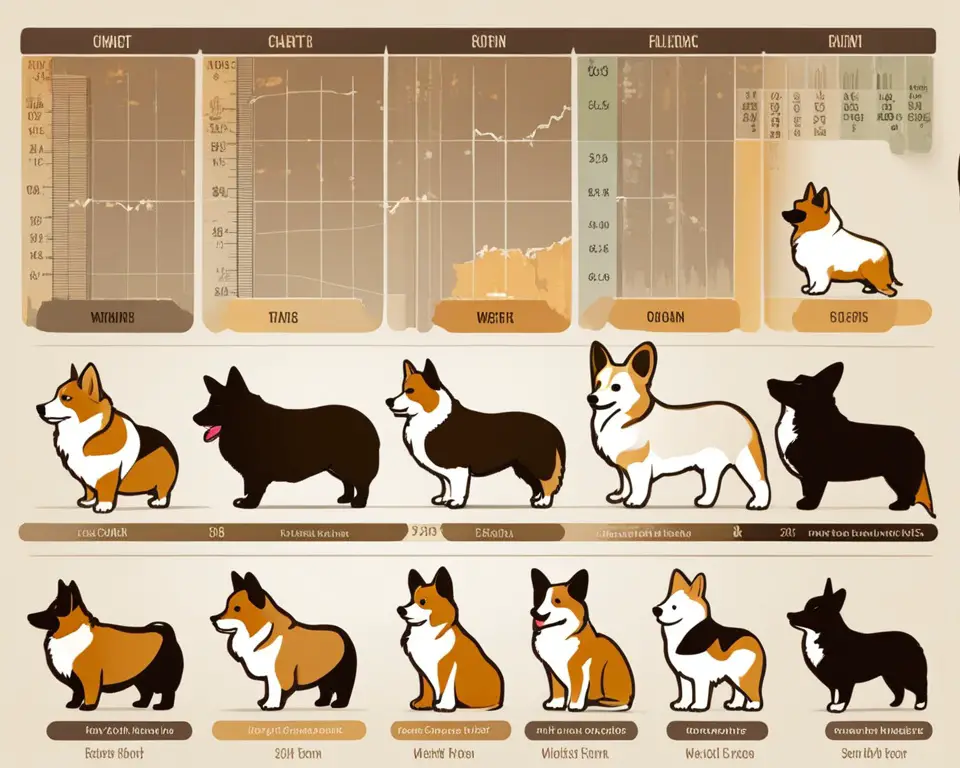
It’s key to know how Corgis grow to keep them healthy. The Corgi puppy growth chart is a must for owners. It shows how a Corgi’s weight should change from when they’re born to becoming an adult. With the Corgi weight milestones, owners can make sure their pet grows as it should.
Look at this chart for an idea of how Corgis grow from a young age. Keep in mind that the Corgi weight guide is just a general view. A Corgi’s growth might change a lot depending on what they eat, how much they move, and their genes.
| Age (Months) | Expected Weight Range (Pounds) |
|---|---|
| 1 | 2-5 |
| 3 | 5-10 |
| 6 | 10-15 |
| 9 | 15-20 |
| 12 | 18-23 |
| 18 | 22-28 |
| 24 | 25-30 |
This Corgi weight chart is a great start for new owners. It helps understand what to expect as their puppy grows. Don’t forget, regular visits to the vet will give you a more precise view of your furry friend’s health needs.
The Growth Phases of a Corgi
The journey of a Corgi from puppy to adult is filled with growth stages. This is known as the Corgi growth phases. Knowing these phases helps owners give the right care. Corgi puppy years are very important for their future health and behavior.
From Puppies to Adolescence
Corgi puppies grow quickly at first. It’s very important to feed them well for their bones, muscles, and organs. They should see the vet often to check their health. This way, any problems can be spotted early and treated.
When Do Corgis Reach Their Full Size?
Most Corgis are as tall as they will get by their first birthday. But they keep gaining weight and muscle up to around two years old. Many things like their genes, sex, and what they eat decide how big a Corgi will be. Males are usually a bit bigger than females.
| Age | Expected Weight Range | Development Stage |
|---|---|---|
| 0-3 Months | 5-12 lbs | Early Puppyhood |
| 4-6 Months | 12-20 lbs | Late Puppyhood |
| 7-12 Months | 20-25 lbs | Adolescence |
| 1-2 Years | 25-30 lbs | Approaching Full Size |
Pembroke vs. Cardigan: Comparing Sizes
Welsh Corgis are fascinating to explore. Especially when we look at the Pembroke and Cardigan breeds. A Corgi breed comparison shows big differences in size, look, and history. This helps anyone thinking of getting a Corgi know which one fits their life and home best.
Distinguishing Between the Two Corgi Breeds
In Wales, the Pembroke and Cardigan Corgis have unique stories. The Pembroke, for example, is from flat lands and has a docked tail. This makes them a bit smaller. Meanwhile, the Cardigan comes from rocky, hilly areas. They have a longer tail and a bigger build.
Typical Size Differences
Looking at a Corgi breed comparison, we see big size differences. The Cardigan Welsh Corgi is usually larger and heavier than the Pembroke. Knowing this is important. It affects how much space and exercise each Corgi needs.
| Breed | Height (inches) | Weight (pounds) |
|---|---|---|
| Pembroke Welsh Corgi | 10-12 | Up to 30 |
| Cardigan Welsh Corgi | 10.5-12.5 | Up to 38 |
Whether you prefer the lively Pembroke or the strong Cardigan, knowing about their sizes is crucial. It helps make sure your pet is happy and healthy in your home.
Expert Insights on Corgi Growth Expectations
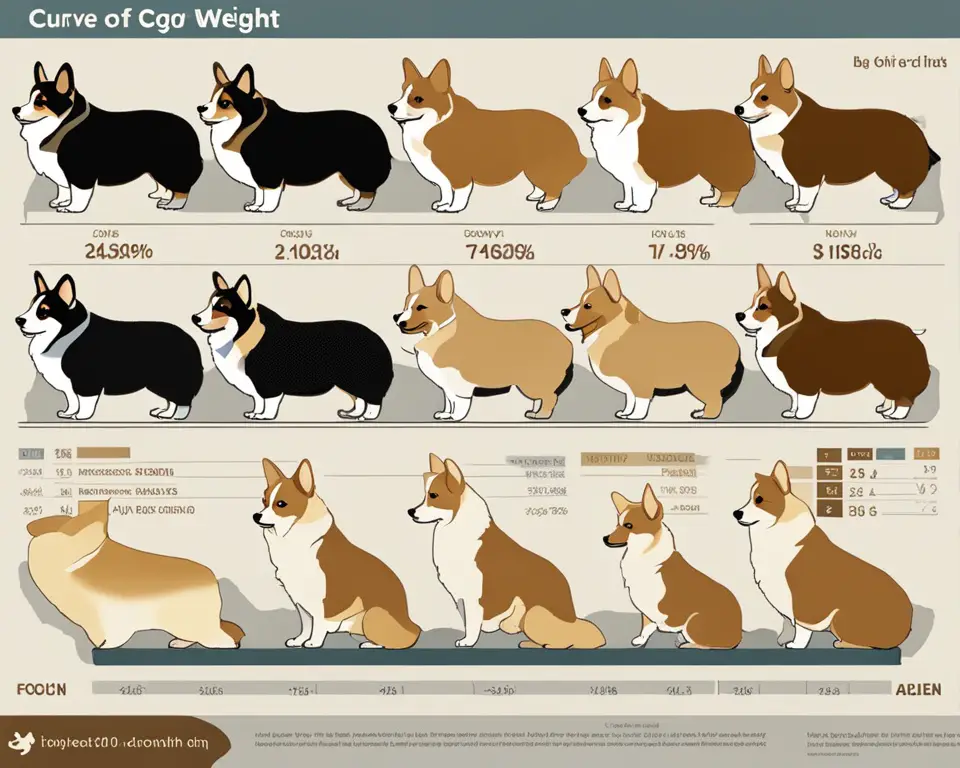
Learning about a Corgi’s growth rate is key for all owners. This knowledge helps ensure that pets grow up healthy. Insights from canine growth expert advice stress knowing the Corgi development stages. Experts say that growth charts are a good start. However, each Corgi’s growth path varies because of genes and health conditions.
Large paws on a Corgi might tell us it’s still growing a lot. Also, comparing a Corgi’s size to its parents can hint at its future adult size. This method helps predict if your Corgi is developing as expected.
- Weekly monitoring of body condition to ensure that the growth is within a healthy range.
- Regular veterinary check-ups to address any health issues promptly.
- Customized nutrition plans tailored to support unique growth needs during different development stages.
It’s crucial to keep a detailed health and growth record for your Corgi. This record is a key tool in managing your pet’s development. It ensures they grow correctly and meet health needs for their breed and age.
“Growth patterns can teach us a lot about a pet’s health. It’s essential to stay informed and proactive at all stages of your Corgi’s development to ensure they lead a healthy and fulfilled life.”
Canine growth expert advice points out understanding a Corgi’s growth involves more than just the numbers. It’s watching their behavior, physical changes, and how they feel. These are signs of healthy growth.
Healthy Weight Ranges for Corgis
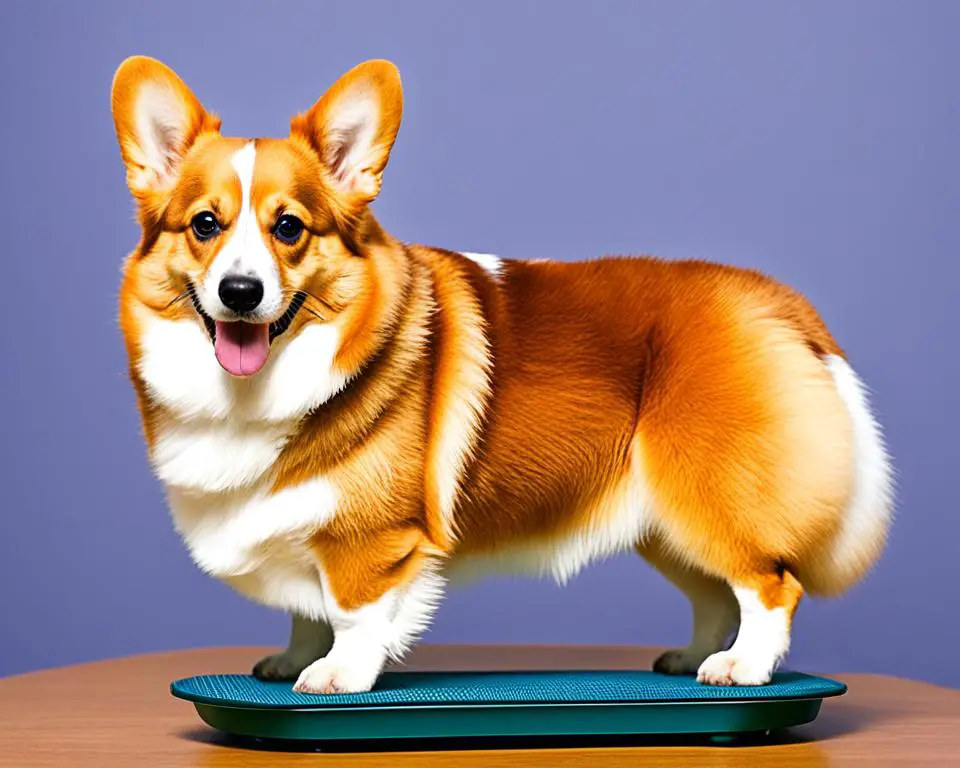
Understanding healthy Corgi weight is key for your pet’s great life. It really improves how they move, feel, and their health. Keeping your Corgi’s weight right matters for all ages, from when they’re pups to full-grown dogs.
Corgis vary in how they grow, influencing their health. A full-grown Corgi can weigh between 22 and 30 pounds. This changes a bit based on gender but not by much. Let’s dive into the weight details:
| Gender | Weight Range |
|---|---|
| Male | 24-30 lbs |
| Female | 22-28 lbs |
Watching your Corgi’s weight is crucial, not just a check mark on a list. It’s about knowing what’s right for them considering their activities and how they grow. Owners should check often to catch any changes early.
Finding any weight changes quickly means you can do something about it fast. This prevents many health problems. Tracking their body keeps your Corgi happy and healthy for years to come.
Corgi weight: Assessment and Management
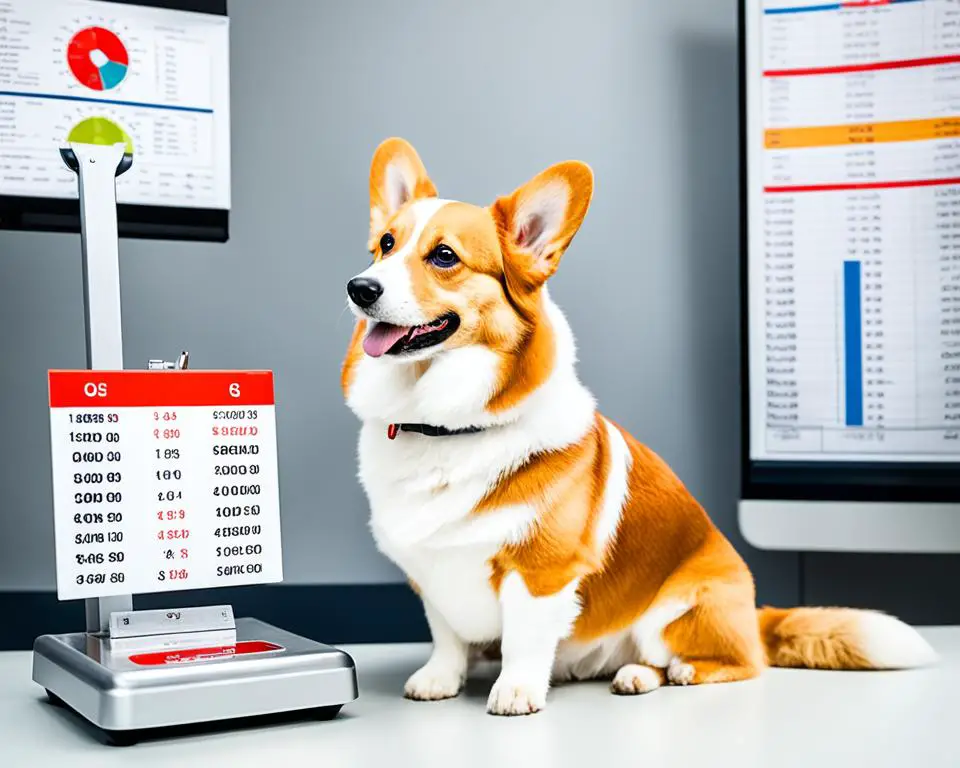
Keeping your Corgi’s weight in check is key from their young years to adult life. It’s vital to oversee their weight to make sure they live healthily. This includes watching their diet and making sure they get enough exercise.
Identifying Overweight and Underweight Corgis
To tell if a Corgi is the right weight, you can look and touch. A fit Corgi has a light waist and you can faintly feel their ribs. They shouldn’t be too skinny or too overweight. This shows they are in good shape.
Weight Management Strategies
To keep your Corgi at a healthy weight, you need a plan that fits them. This involves checking what they eat and making sure they move around enough. It’s also about not giving them too many high-calorie snacks.
Weigh your Corgi regularly so you can adjust their food as needed. This keeps their weight in the right zone.
Role of Diet and Exercise
The key to a Corgi’s weight is the right mix of food and exercise. Feed them foods that match their needs to stay healthy. And, make time for activities like walks and play every day. This helps avoid them getting too heavy.
If you take a hands-on approach to your Corgi’s weight, they will be happier and healthier. Choosing the right food and exercise can do wonders for them. It boosts their health and happiness.
Factors Influencing Corgi Weight

It’s vital to know the many factors that can change a Corgi’s weight for their health and happiness. Things like genetic background and even operations can make a big difference in how heavy or light a Corgi is. Each one has a special effect on a Corgi’s body size and shape.
Genetics and Weight Potential
Corgis get a lot from their family line when it comes to their body. Being part of a breed with different sizes, Corgis can have big differences in how they look. Their genetics control things like how long their legs are and their body weight.
Impact of Spaying/Neutering on Weight
Spaying or neutering a Corgi can slow their metabolism down. This might make them gain weight easier. It’s key to watch their diet and make sure they get enough exercise. This helps keep them at a healthy weight.
Maintaining Your Corgi’s Ideal Weight
Keeping your Corgi at the right weight means watching what they eat and how much they play. It’s important to fit these parts exactly to what your dog needs. This ensures they live a happy and healthy life.
Appropriate Feeding Practices
Feeding your Corgi right is crucial. It’s about giving them the right amount of food. This takes care of their nutrition without making them overweight. Here’s how to do it:
| Life Stage | Recommended Daily Caloric Intake | Suggested Foods |
|---|---|---|
| Puppy (up to 1 year) | 500-800 Calories | High-protein puppy formula, soft vegetables, healthy grains |
| Adult (1-7 years) | 700-900 Calories | Lean meats, fibrous vegetables, essential fatty acids |
| Senior (7 years and up) | 400-600 Calories | Senior-specific formulas with glucosamine, low fat |
Feed your Corgi at the same time every day. This stops them from eating too much or too little. It’s key to help them stay at a healthy weight.
Regular Exercise Routines
Exercise is vital for your Corgi. It keeps them looking good and feeling well. Include both play and brain workouts in your daily plan.
- Daily walks (at least 30 minutes)
- Interactive play sessions such as fetch or tug-of-war
- Corgi-friendly agility exercises
- Herding activities which play on the Corgi’s natural instincts
Change the exercises based on your Corgi’s age and health. Staying active is crucial for their weight and health.
Corgi Weight and Overall Health
It’s key for Corgi owners to grasp the link between Corgi health concerns and weight. Looking after what Corgis eat and how they exercise is essential. This ensures they stay at a good weight and avoids health problems.
Common Health Concerns Related to Weight
Changes in a Corgi’s weight can really affect their health. If they gain too much weight, they might have trouble with their joints or get diabetes. They could also find it hard to breathe.
If a Corgi is underweight, it might mean health troubles or not enough food. This can make them weak or sick. So, it’s important to keep an eye on their weight to avoid these big health problems.
The Role of Regular Veterinary Check-ups
Visiting a vet often is crucial for a Corgi’s health. Vets can spot health issues early and advise on caring for your Corgi. This might mean changing what they eat or how they exercise based on professional help.
Vets also do important things like give shots, check for problems, and care for the teeth. These things help keep serious health issues and common Corgi health concerns away. Putting a focus on prevention through regular checks can keep a Corgi happy and healthy for longer.
| Health Concern | Risks Associated With Obesity | Risks Associated With Being Underweight |
|---|---|---|
| Joint Problems | Increased | Low Impact |
| Heart Disease | High Risk | Low Risk |
| Energy Levels | Decreased | Decreased |
Conclusion
We’ve looked at how managing a Corgi’s weight is key to their health. Each type of Corgi grows in its special way, making responsible pet care important. At around one year old, a Corgi is usually fully grown. Their size depends on their breed and how well they are taken care of.
Getting a Corgi to grow healthily involves many things. It’s important to consider their genetics and what they eat. Boys and girls Corgis don’t grow the same, with boys often being bigger. How long their legs are is also linked to their genes. Proper care and regular vet visits are crucial for keeping a Corgi healthy. This helps avoid common health problems from being overweight, making for a happier dog life.
For detailed growth information, check out how big does a Corgi get. Knowing these growth details and being a responsible owner helps your Corgi thrive. Make sure they eat well and get enough exercise. With good care, your Corgi will bring joy for many years.
Source Links
- https://www.pawlicy.com/blog/corgi-growth-and-weight-chart/
- https://www.dogster.com/dog-breeds/how-big-does-a-corgi-get
- https://iheartdogs.com/male-female-corgi-weights-heights-by-age/




